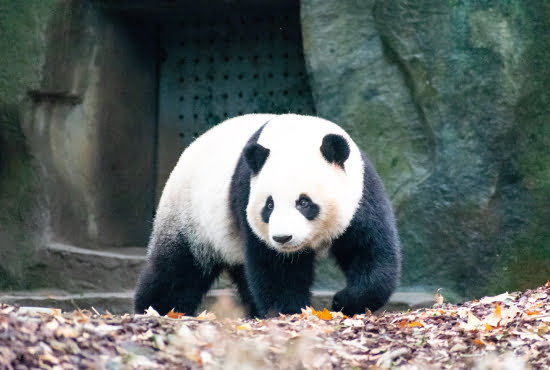Introduction Of Giant Panda
The giant panda (Ailuropodamelanoleuca) is a type of bear native to China. Native to mountain forests in central and southern China, it lives about 20 years in captivity. The panda is recognized as a symbol of conservation. 69 pandas are living in zoos outside China. The WWF’s global goal is to create a system of 42 interconnected panda reserves by 2015, covering an area equivalent to 7% of China’s territory. So far, thirteen have been established in seven regions: Sichuan, Shaanxi, Gansu, Shanxi, and Qinghai provinces; and Pudacuo National Park on Hainan Island. (Ecotourism Society)

Diet Of Giant Panda
Although bamboo makes up 99% of a giant panda’s diet, these herbivores don’t survive solely on shoots and leaves. Pandas have been observed eating small rodents, birds, eggs, insects, and even carrion. Due to their inability to properly digest meat, pandas sometimes develop intestinal problems that make it impossible for them to absorb sufficient nutrients from bamboo; thus, they must eat other foods to live. Occasionally pandas will also consume grasses, fish, and mushrooms when available.
Additionally, pandas spend around 10 hours a day gathering food due to their low-calorie diets. An adult need at least 26 pounds of vegetation each day to survive—that’s just over 7 million calories per year! Even given the specialized digestive system that allows them to derive about 37% more energy from bamboo than any other species (and makes them one of nature’s most efficient feeders), most giant pandas need about 18 hours of feeding time every day.

Physical Characteristics
The giant panda is a medium-sized bear that belongs to an ancient group of mammals called procyonids. They are related to raccoons, coatis, kinkajous, and other omnivorous mammals called procyonids. The panda’s closest living relative is called a red panda. These small mammals are native to eastern Asia, including China and Nepal. Despite its size, it can climb trees quickly because of its strong hind legs.
Pandas have black circles around their eyes like spectacles and white muzzles with black coloration around their mouths. Their thick, long fur is grey or yellowish in color with darker patches on their shoulders. Male pandas weigh between 100–150 kilograms (220–330 pounds) whereas females are smaller at about 90 kilograms (200 pounds). Adult pandas stand approximately 1 meter (3 feet) tall at shoulder height when on all fours but may stand as tall as 2 meters (6 feet) when sitting upright or rearing up on their hind legs.

Incredible Facts
Adult giant pandas can grow to be around 100 pounds. After being born, they spend their first six months nursing from their mothers and don’t begin to eat bamboo until later on. Giant pandas are black and white in color, have round faces, large muzzles, and small ears. They can live up to 25 years in captivity; they’re only considered adults after eight years of age.
Females reach sexual maturity between four and eight years old; males mature at five or six years old. In 2011, pregnancy was documented for a panda living at Tokyo’s Ueno Zoo–the first panda birth in Japan in 24 years. Unfortunately, her cub died shortly after it was born.
About 1,600 giant pandas are living in zoos throughout China and another 300-500 that are thought to remain in captivity within the wild range which spans from western Sichuan through eastern Qinghai and into Gansu Province (about 12% of its historic habitat).
Their numbers have declined due to factors such as habitat loss, poaching, and natural disasters. If they aren’t cared for properly while they’re young, females may refuse to mate as adults if they feel any human contact is too close for comfort.
They have sturdy bodies and thickly padded feet. While they are mostly herbivorous, they have been known to eat small animals, insects, eggs, and even fish in captivity. On occasion, they will scavenge meat from carcasses; giant pandas often scent-mark their territories by urinating or defecating nearby.
The giant panda is a terrestrial animal and primarily spends its life roaming and feeding in the bamboo forests of China’s southern mountains.[13] Despite being native to steep mountain ranges with little access to water sources,[14] it has been recorded on the occasion that they will venture out into flat grasslands.[15] When moving on flat terrain (such as cultivated fields), they can cover 5–10 km (3–6 mi) in a day

